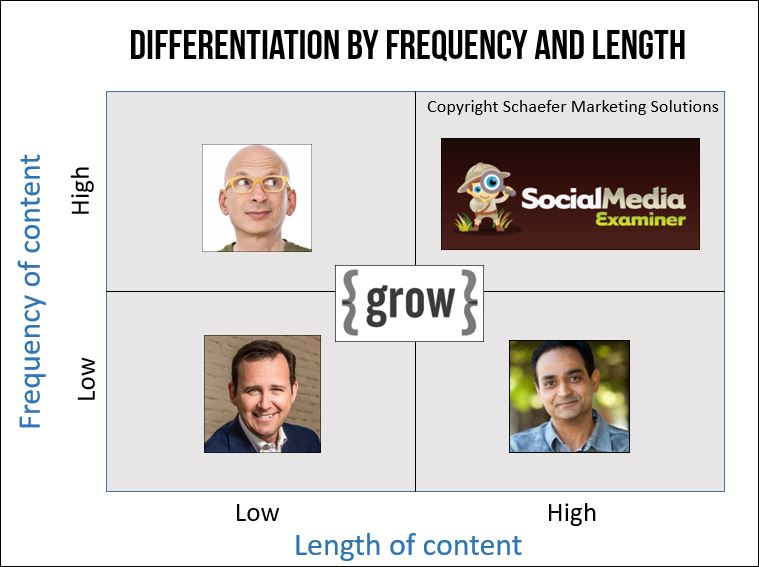
The name of the game is to find a way to stand out in your industry … even if it’s crowded. Today I want to help you consider a way to differentiate your blog by thinking strategically about how you use your productivity and the amount of time you put into writing.
Blogging takes a lot of work. Are you using your time to maximum effectiveness?
Your blogging output
How much time can you devote to blogging? If you spend 4-5 hours a week creating content, is it better to spend all of that time on one epic post for the month or pump out a number of shorter posts spread out over weeks? How can you decide?
There are lots of ways to look at it, but one thing you might consider in your decision is the competitive landscape. Maybe your strategy should be determined by an opportunity for differentiation through your publishing schedule. Let’s look at a few of the top marketing blogs as an example of using the time you put into blogging (or any kind of content creation) as a competitive angle.
The field of marketing blogging is extremely competitive but to make my point, here’s how a few familiar bloggers are positioned:

Of the five blogs represented here, four of the authors probably commit about the same amount of time to their blog each week. But the strategies and results of that time commitment are remarkably different. They are using time as a strategy to appeal to a certain audience. Let’s take a closer look.
High frequency, low length — Seth Godin publishes almost every day but his posts rarely exceed 500 words … and sometimes they are as short as a just few sentences! Seth is an industry thought leader and his posts are pithy observations of the business world. Those short articles probably appeal to busy people who only have time for small chunks of content.
Low frequency, low length — Scott Monty only publishes once or twice a week, usually a short business observation and a helpful weekly industry round-up. While Scott publishes infrequently, he puts an incredible amount of time into his curated weekly highlights post. It’s probably just 1,000 words in length but packs a lot of punch. Essentially he is spending his precious blogging time in a way that saves you time.
Low frequency, high length — Avinash Kaushik of Google writes truly epic posts. He may only publish once a month, but when you get his post in your in-box, grab a snack and prepare to settle in for a while. A few of his highly-detailed posts have been mini-books exceeding 10,000 words! Reading an Avinash post is not for everyone but if you you thirst for deep analytical insight (and have the time to read it), there is no better source.
Moderate frequency, moderate length — Here on {grow} I publish thought-provoking posts (like this one) of moderate length several times a week. I also feature regular paid guest columnists like Kerry Gorgone, Eric Wittlake, Mars Dorian, Brooke Ballard, and Kiki Schirr to offer diverse, expert views on interesting topics that might be out of my normal reach.
How did I decide on this formula for {grow}? Reader feedback and surveys. I used to publish shorter, more frequent posts but I found that my competitive sweet spot is medium-length posts published no more than four times per week. Long-time readers might even remember I used to feature weekly cartoons as a way to stand out but I learned this was just not consistent with what my readers expected. For my specific audience, I seem to be at an ideal publishing rate.
Now these great blogs I’ve mentioned certainly do not make their mark through publishing strategy alone. They are also outstanding in their unique tone, original subject matter, and writing style. But the point I’m making is that all four authors are also using their time in profoundly different ways to stand out from the pack and make an impact.
The final category on my chart is high frequency, high length. There probably isn’t any way to be both prolific and lengthy without either turning blogging into a full-time job or getting creative with the approach, which is precisely what Social Media Examiner does every day by using a cadre of staff and unpaid guest writers. The minimum length of an SME post is 1,000 words and they publish eight times per week. There is certainly a place for this approach as well in some industries.
Your blogging strategy
The most important aspect of your blog is this — you need to be interesting. All the time. That’s not easy.
But if you commit to the hard work, find your voice, and identify an un-saturated niche, you can also stand out by HOW you use your time.
If you completed a diagram like this for your industry, is there an open slot?
- If competitors are filling the airwaves with frequent, short posts, does it make sense to distinguish yourself by writing less frequently, but in-depth?
- If your competitors are posting once a month, could you break from the pack by posting once a week or more?
- Could you stand out like Scott Monty and devote your blogging time to skillful curation at a low frequency?
- Is there room for a Social Media Examiner model in your industry?
Examining frequency and length is a new way to think about using your personal blogging time in a more strategic way.
Does this open up an opportunity for you?
Illustration courtesy Flickr CC and Robert Couse Baker.
To view the original article Click Here

No comments:
Post a Comment